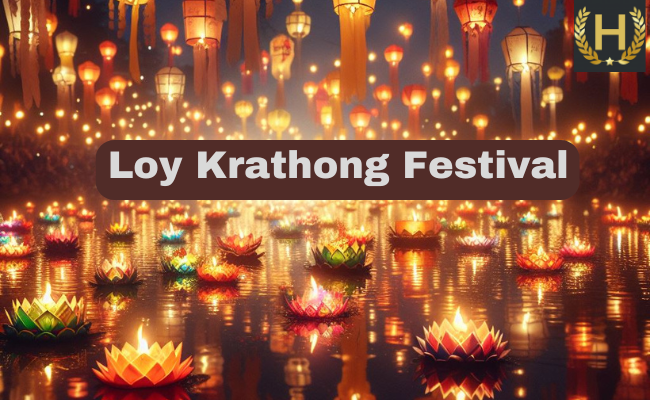Loy Krathong is an annual Thai holiday Celebrated throughout Thailand and neighboring countries with strong South Western Tai cultures. The word, which can be translated as “to float ritual vessel or lamp,” comes from the habit of crafting krathongs, or buoyant, painted baskets, and then floating them down a river. Many Thais use the krathong to thank the Goddess of Water and River, Goddess Khongkha, or to venerate the Holy Buddha’s hair pagoda in heaven, as per Buddhist teachings. This celebration traces its origins to India.
Origin
It is widely believed that Loy Krathong originated under the Sukhothai Kingdom (1238–1438). The classical literature Tamrap Thao Si Chulalak [ตํารับท้าวศรีจุฬาลักษณ์] tells of a lady named Nang Noppamas, who was a high-ranking concubine of the King of Sukhothai. During an annual event in which royals offered votive floats in honor of the Buddha, Nang Noppamas created a beautiful float shaped like a lotus and ornamented with small birds. Later, this float served as the foundation for the krathong. The story also inspired Nang Noppamas-themed beauty pageants, another popular Loy Krathong tradition.
Academics, on the other hand, believe that Loy Krathong’s beginnings predate the Sukhothai period. Historian Prince Damrong Rajanubhab (1862–1943) suggests that King Nangklao (1824–1851) likely wrote the story of Tamrap Thao Si Chulalak later. Thus, subsequent generations may have formed the association of krathongs with Nang Noppamas.
Southeast Asia, and even East Asia, have common festivals and traditions involving the floating of offerings. People in the Southeast have long believed in ghosts who live in water and on land. To express gratitude to these spirits, individuals would make tiny offerings in vessels made of banana leaves or stems and set them on the ground or in waterways. The origin of the tradition of floating offerings remains uncertain, but the earliest depictions of this custom date back to around 1208 in Bayon, Cambodia. When Buddhism and Hinduism arrived in the region, the offerings became objects of worship for Buddha and Hindu deities rather than native spirits. Other historians assert that the Chinese tradition of floating paper lanterns influenced the components of Loy Krathong.
When is the Loy Krathong festival Celebrated?
The Loy Krathong Festival usually takes place on the evening of the 12th full moon in the Thai lunar calendar. It usually occurs in November, according to the Western calendar. As a result, the Loy Kratong date is subject to change. It varies each year based on the full moon. In 2024, it will take place on the evening of November 16th.
The event in Chiang Mai lasts three days; in 2018, it was held from November 21 to 23. In Thailand, the celebration is known as Loi Krathong. This celebration is known as “Tazaungdaing Festival” in Myanmar, “Il Full Moon Poya” in Sri Lanka, “Lantern Festival” in China, and “Bon Om Touk” in Cambodia.
What exactly is the meaning of “Loy Krathong”?
‘Loy (ลอย)’ means ‘to float’.
‘Krathong’ translates as ‘basket or boat’.
So, “Loy Krathong” means “to float a basket.”
As the name implies, Thais assemble along rivers, lakes, and canals to release baskets on the evening of the celebration. This act represents letting go of negative feelings and showing respect to the water spirits.
What is a Krathong?
Krathongs are miniature, decorative floats constructed largely of banana leaves that resemble lotus flowers or little boats. Flowers, candles, incense sticks, and, on occasion, cash or small contributions are used to decorate the krathong. During the event, floating krathongs carry people’s hopes, wishes, and thanks as they travel rivers, lakes, and canals.
How is Loy Krathong celebrated in Thailand?
Loy Krathong is a bright and significant Thai celebration. Here’s how people usually celebrate this festival:
1. Krathong making: Traditionally, Thai people start the festival by crafting Krathongs at home with friends and family, however many also buy them from local shops.
2. Floating Krathongs: At sunset, people congregate near water bodies to display their decorated krathongs. They light the candles and incense before carefully releasing the krathongs into the water, symbolizing the release of negativity and respect for the water spirits. According to Thai legend, if the krathong is lit until it vanishes out of sight, it would bring good luck the following year.
3. Cultural Performances and Beauty Pageant: Visitors to Loy Krathong can enjoy folklore performances, lantern parades, fireworks displays, and Thai classical music concerts. There will often be a beauty pageant in which women would dress in traditional Thai attire.
4. Lantern Release: In some areas of Thailand, such as Chiang Mai, an extra custom involves releasing floating lanterns known as “khom loi” into the sky. These lanterns represent the release of worry and the desire for a better future.
5. Food and Entertainment: Loy Krathong is also a time for feasting. People frequently eat great street food, including local specialties and traditional Thai meals.
